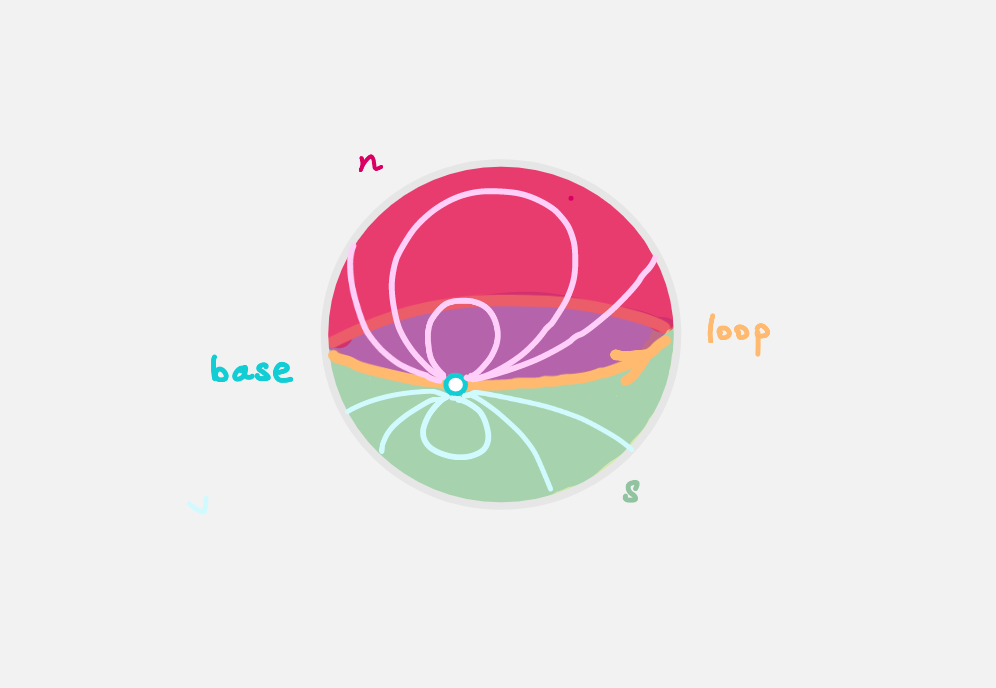The loop space can contain higher homotopical information that
the fundamental group does not capture.
For example, consider `S²`.
```agda
data S² : Type where
base : S²
loop : base ≡ base
northHemisphere : loop ≡ refl
southHemisphere : refl ≡ loop
```
What is `refl`?
For any space `A` and point `a : A`,
`refl` is the constant path at `a`.
Technically speaking, we should write `refl a` to indicate the point we are at,
however `agda` is often smart enough to figure that out.
Intuitively, all loops in `S²` based at `base` is homotopic to
the constant path `refl`.
In other words, the fundamental group at `base` of `S²` is trivial.
However, the 'composition' of the path `southHemisphere` with `northHemisphere`
in `base ≡ base` gives the surface of `S²`,
which intuitively is not homotopic to the constant point `base`.
So `base ≡ base` has non-trivial path structure.
 Let's be more precise about homotopical data :
We can check that a space is 'homotopically trivial' (h-trivial)
from dimension `n`
by checking if spheres of dimension `n` can be filled.
To be h-trivial from `0` is for any two points
to have a line in between; to fill `S⁰`.
This data is captured in
```agda
isProp : Type → Type
isProp A = (x y : A) → x ≡ y
```
Let's be more precise about homotopical data :
We can check that a space is 'homotopically trivial' (h-trivial)
from dimension `n`
by checking if spheres of dimension `n` can be filled.
To be h-trivial from `0` is for any two points
to have a line in between; to fill `S⁰`.
This data is captured in
```agda
isProp : Type → Type
isProp A = (x y : A) → x ≡ y
```
All maps are continuous in HoTT
There is a subtlety in the definition `isProp`.
This is _stronger_ than saying that the space `A` is path connected.
Since `A` is equipped with a continuous map taking pairs `x y : A`
to a path between them.
We will show that `isProp S¹` is _empty_ despite `S¹` being path connected.
Similarly, to be h-trivial from dimension `1` is for any two points `x y : A`
and any two paths `p q : x ≡ y` to have a homotopy from `p` to `q`;
to fill `S¹`. This is captured in
```agda
isSet : Type → Type
isSet A = (x y : A) → isProp (x ≡ y)
```
To define the fundamental group we will make the loop space satisfy
`isSet` by _trucating_ the loop space'.
First we show that `isProp S¹` and `isSet S¹` are both empty.
Locate `¬isSetS¹` in `1FundamentalGroup/Quest1.agda`.
In the cubical library we have the result
```agda
isProp→isSet : (A : Type) → isProp A → isSet A
```
HLevel
Generalisation to HLevel and isHLevel n → isHLevel suc n??
which we will not prove.
Use `isProp→isSet` to conclude `¬isPropS¹` (using `¬isSetS¹`),
from now you should fill in the hypotheses of the proof yourself
(put `h` before the `=` sign or use `C-c C-r`).
Turning our attention to `¬isSetS¹`,
again supposing `h : isSet S¹` -
a map continuously taking each pair `x y : A`
to a point in `isProp (x ≡ y)`.
We can apply `h` twice to the only point `base` available to us,
obtaining a point of `isProp (base ≡ base)`.
Can we map this into the empty space?
Hint 0
We have already shown that `Refl ≡ loop` is the empty space.
We have imported `Quest0` for you, so you can just quote the
result from there.
Hint 1
- assume `h`
- type `Refl≢loop` it in the hole and refine
- it should now be asking for a proof that `Refl ≡ loop`
- try to use `h`
 Let's be more precise about homotopical data :
We can check that a space is 'homotopically trivial' (h-trivial)
from dimension `n`
by checking if spheres of dimension `n` can be filled.
To be h-trivial from `0` is for any two points
to have a line in between; to fill `S⁰`.
This data is captured in
```agda
isProp : Type → Type
isProp A = (x y : A) → x ≡ y
```
Let's be more precise about homotopical data :
We can check that a space is 'homotopically trivial' (h-trivial)
from dimension `n`
by checking if spheres of dimension `n` can be filled.
To be h-trivial from `0` is for any two points
to have a line in between; to fill `S⁰`.
This data is captured in
```agda
isProp : Type → Type
isProp A = (x y : A) → x ≡ y
```